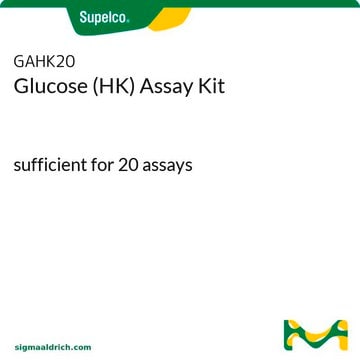MAK083
Glucose Uptake Colorimetric Assay Kit
sufficient for 100 colorimetric tests
Sign Into View Organizational & Contract Pricing
All Photos(3)
About This Item
UNSPSC Code:
12161503
NACRES:
NA.84
Recommended Products
usage
sufficient for 100 colorimetric tests
detection method
colorimetric
relevant disease(s)
endocrinological disorders, diabetes; cancer
storage temp.
−20°C
General description
Glucose is the primary source of energy for most cells. Glucose uptake into cells is highly regulated and the first rate limiting step in glucose metabolism. Glucose uptake is facilitated by the GLUT family of transporter proteins, whose expression and activity are regulated by multiple mechanisms. Glucose uptake is upregulated in many cancer cells, which exhibit high rates of aerobic glycolysis. Cells exhibiting insulin resistance show diminished glucose uptake in response to insulin stimulation.
The use of the recycling amplification reaction in the colorimetric assay results in the limit of detection being 10-fold lower (20-100 pmole) compared to the fluorescence assay (200-1,000 pmole, MAK084).
The use of the recycling amplification reaction in the colorimetric assay results in the limit of detection being 10-fold lower (20-100 pmole) compared to the fluorescence assay (200-1,000 pmole, MAK084).
Application
Glucose uptake colorimetric assay kit has been used to measure glucose uptake by a variety of cells.
Suitability
Suitable for detecting glucose uptake in adherent or suspension cells cultured in a 96-well microtiter plate.
Principle
The Glucose Uptake Colorimetric Assay kit provides a simple and direct procedure for measuring glucose uptake in a variety of cells. Glucose uptake is measured using the glucose analog, 2-deoxyglucose (2-DG), which is taken up by cells and phosphorylated by hexokinase to 2-DG6P. 2-DG6P cannot be further metabolized and accumulates in cells, directly proportional to the glucose uptake by cells. In this assay, 2-DG uptake is determined by a coupled enzymatic assay in which the 2-DG6P is oxidized, resulting in the generation of NADPH, which is then determined by a recycling amplification reaction in which the NADPH is utilized by glutathione reductase in a coupled enzymatic reaction that produces glutathione. Glutathione reacts with DTNB to product TNB, which is detected at 412 nm.
related product
Product No.
Description
Pricing
replaced by
Product No.
Description
Pricing
Certificates of Analysis (COA)
Search for Certificates of Analysis (COA) by entering the products Lot/Batch Number. Lot and Batch Numbers can be found on a product’s label following the words ‘Lot’ or ‘Batch’.
Already Own This Product?
Find documentation for the products that you have recently purchased in the Document Library.
Huijuan Shi et al.
Frontiers in oncology, 10, 1034-1034 (2020-08-09)
Colon cancer is one of the most prevalent malignancies that lead to high occurrence of cancer-related deaths. Currently, chemotherapies and radiotherapies remain the primary treatments for advanced colon cancer. Despite the initial effectiveness, a fraction of colon cancer patients developed
Kyung-Ah Cho et al.
International journal of molecular medicine, 36(3), 839-844 (2015-07-15)
Impaired lipid metabolism and inflammatory pathways have individually been implicated in the development of insulin resistance in skeletal muscle; however, little evidence is available to date linking the two in this context. In this study, we explored a potential molecular
PLIN2 inhibits insulin-induced glucose uptake in myoblasts through the activation of the NLRP3 inflammasome.
Cho K A and Peter B K
International Journal of Molecular Medicine, 36(3), 839-844 (2015)
Sho Morioka et al.
Nature, 563(7733), 714-718 (2018-11-23)
Development and routine tissue homeostasis require a high turnover of apoptotic cells. These cells are removed by professional and non-professional phagocytes via efferocytosis1. How a phagocyte maintains its homeostasis while coordinating corpse uptake, processing ingested materials and secreting anti-inflammatory mediators
MicroRNA-138 suppresses proliferation, invasion and glycolysis in malignant melanoma cells by targeting HIF-1α.
Chen Y, et al.
Experimental and Therapeutic Medicine, 11(6), 2513-2518 (2016)
Our team of scientists has experience in all areas of research including Life Science, Material Science, Chemical Synthesis, Chromatography, Analytical and many others.
Contact Technical Service

![2-Deoxy-2-[(7-nitro-2,1,3-benzoxadiazol-4-yl)amino]-D-glucose ≥97% (HPLC)](/deepweb/assets/sigmaaldrich/product/structures/104/527/40bd5a41-ebc4-484e-a10e-891fecfaea79/640/40bd5a41-ebc4-484e-a10e-891fecfaea79.png)



